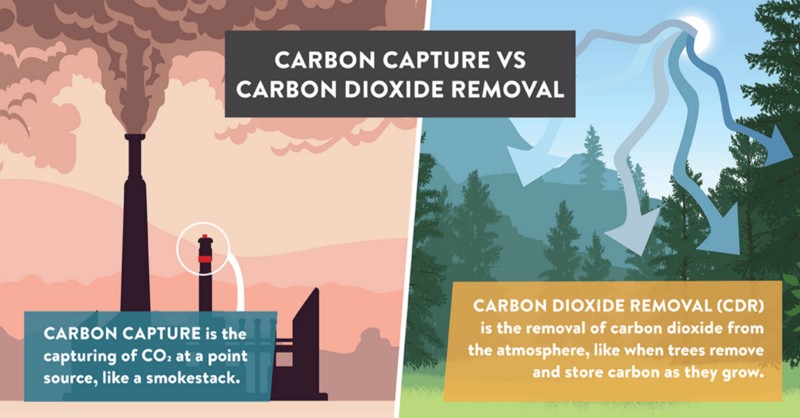The 3 Pillars of Climate Restoration
What’s all the Hype with Carbon Dioxide Removal? Is It the Same as Climate Restoration?
Carbon dioxide removal has recently received extra buzz thanks to Elon Musk and his $100M competition with XPRIZE to find the best carbon removal technology out there. While the hype is encouraging — anything to drive climate action is paramount — it’s important to understand how carbon dioxide removal stands apart from climate restoration.
Carbon dioxide removal (CDR) is the removal of carbon dioxide from the atmosphere. This differs from carbon capture, which is capturing CO2 at a point source, like a smokestack. CO2 from both CDR and carbon capture can be used in a multitude of ways, such as synthetic jet fuel and soda. Remember, these terms simply refer to where the CO2 is coming from, not necessarily where it’s going.
Carbon capture is important for a variety of reasons:
- It provides more concentrated input streams of CO2 than the atmosphere, making the capture process cheaper and more efficient;
- It allows industries with hard-to-avoid emissions to prevent their emissions from reaching the atmosphere;
- It helps grow the supply of CO2 that can be used in commercial products, allowing us to build up a market for the CO2 that will be removed from the atmosphere.
Carbon capture processes are a good thing unless they’re taken advantage of, say, by a coal plant with no intention of transitioning to renewable energy, but wants good PR and tax credits from capturing their emissions and burying them underground.
CDR will ultimately allow us to reach net-negative emissions because it doesn’t rely on emissions as a source of CO2. As you may imagine, removing CO2 from the ambient air is significantly harder than pulling it from emissions since it exists in dramatically lower concentrations. Furthermore, there is less CDR infrastructure in place as it’s a newer field.

The goal of climate restoration calls for us to reduce atmospheric concentrations of CO2 to below 300 ppm by 2050. This would require the removal of about 50 billion tons (Gt) of CO2 from the atmosphere per year between 2030 and 2050. Responsible efforts to build up carbon capture and CDR capacity will contribute to building the massive markets and infrastructure needed to achieve this goal.
Here’s the key differentiator between CDR and climate restoration
You could have successful CDR initiatives to convert CO2 into diamonds (shoutout to Aether Diamonds!), use ocean waves for enhanced rock weathering (hey, Project Vesta!), or bury CO2 underground (we see you Carbon Engineering!). However, not all initiatives are created equal, even though they are contributing to building up the technologies and markets needed for climate restoration to succeed.
Climate restoration is a specific and measurable goal and calls for safe and responsible CDR approaches that can meet particular specifications. The 3 pillars of climate restoration are:
- Permanence (or, Durability): CDR technologies we deploy must permanently remove the atmospheric CO2 that is warming our planet. This means that net-neutral solutions, like converting CO2 into jet fuel, are not well-suited to climate restoration, even though they contribute to mitigation goals.
- Scalability: CDR technologies for climate restoration should reach a scale on the order of tens of gigatons. We need the ability to implement CDR technologies at a massive scale if we’re to remove all historic emissions accumulated from the past century.
- Financeability: CDR technologies that fit the climate restoration goal need to have an existing customer. It might be corporations looking to buy carbon removal credits off the voluntary carbon market, or government grants, subsidies, or tax credits. Even better are solutions that convert CO2 into commercial byproducts that serve huge existing markets, like concrete, the second most consumed product in the world, behind water.
As you continue on your climate restoration journey and learn about CDR innovations, it’s important to keep in mind how they fit with these three pillars of climate restoration. Stay tuned as we cover more on the movement to restore the climate.